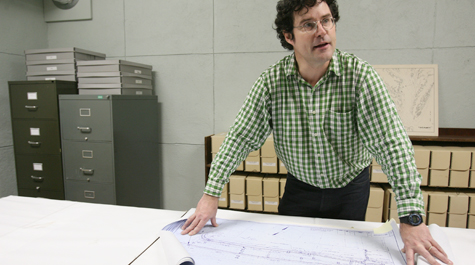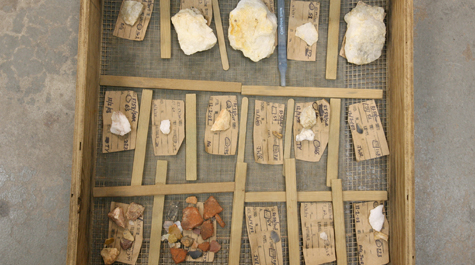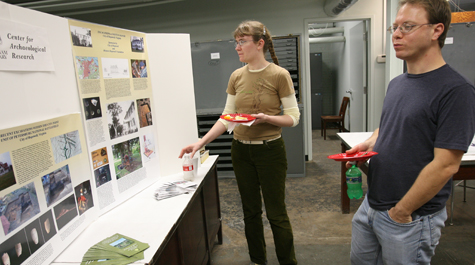Dig this: WMCAR is 20
The William & Mary Center for Archaeological Research held an open house on Dec. 10 to celebrate both its 20th anniversary and to show off its new lab in the basement of Trinkle Hall.
Open-house attendees looking for golden skulls or other Indiana Jones-type artifacts would be disappointed, says Joe Jones, center director—and no relation to Indiana.
“Indiana Jones and the Hollywood version of archaeologists blur the lines between artifacts that are worth money and the kind of artifacts that have value to archaeologists,” Jones said. “Archaeologists typically see the information value of artifacts as very different from their monetary value or what antique collectors think of. We’re interested in things like nails and brick fragments and patterns of those things in the ground and what it tells us about what was there. We get excited about stuff that most people will look at and say, ‘Huuuh?’”
The Center for Archaeological Research functions as William & Mary’s archaeological consultants, working on grants and contracts. Jones explained that a typical WMCAR project begins with governmental sensitivity to the past. Laws stipulate that roads or other projects built with federal or state funding be constructed in a way that will not destroy significant archaeological resources.
“The first step in all of that is to get archaeological consultants like us and send us a copy of the plans,” Jones said. “We sample the area where they’re propose to build the road—doing shovel tests at regular intervals—to make sure there’s nothing significant there. And if there is, then this is all done far enough ahead of time so that they may be able to make management decisions to incorporate some sensitivity to the resources.”
It's not just roadwork
Not all WMCAR projects are advance work on roads, however. Center archaeologists have worked at sites near the Colonial Parkway and at the Northern Neck birthplace of James Monroe. Whether they’re from shovel tests at a road site or childhood home of a U.S. president, artifacts come into the lab in paper bags. Each bag is labeled with information related to the object’s provenance—contextual data about where and when the item was found. The bags are turned over to lab manager Debbie Davenport, who processes their contents and prepares them for curation and storage. The curation process begins with cleaning of the artifacts.
“I simply wash them,” Davenport said, although some materials just get a dry brushing. After cleaning, the objects are placed in partitioned drying trays, each item in its own square. Davenport makes sure the provenance information for each item stays with it—in the drying tray and throughout the entire curation process.
“I did some historical artifacts today that dated from 1775 all the way up to the 20th Century,” Davenport explained. “The appropriate person will get these artifacts, put them in plastic bags and then we catalog them according to a hierarchical system. That is then put into the computer. We generate inventories that are sent along to the archaeologists who study them and write reports.”
30,000 artifacts (and up)
Davenport presides over a collection that usually includes some 30,000 individual artifacts on any given day. The new lab in the basement of Trinkle Hall provides more storage space than the center’s old facility, which was at the edge of the old Common Glory parking lot. The old building was removed during construction of the new Alan B. Miller Hall of the Mason School of Business.
Jones and Davenport both said the additional space in the new Trinkle Hall lab will come in handy, especially in times in which the excavations are more fruitful than usual.
“There was one project that we did that generated more than 10,000 artifacts unexpectedly,” Davenport said. “We did not know that was going to be part of our data recovery on that particular project.”
The Dec. 10 open house, Jones said, was partially due to the urgings of colleagues at the College who kept asking to see the new lab. As part of the observances, the staff prepared a comprehensive index of all WMCAR technical reports produced since 1988.
Boon to scholarship
“Someone who might be interested in the archaeology of 19th-Century farmsteads can go through the index and right away everything we’ve about sites like that,” Jones said. “This would lead them to a chronological list of reports.” Reports themselves are on file either in the lab or in the WMCAR offices on Richmond Road. Copies of the index were distributed at the open house.
The open house also featured a poster session depicting some of the center’s more significant projects. One poster outlined the discovery of evidence of a commercial manufacture of tobacco pipes dating from the 1630s at what is now City Point in Hopewell.
“We found lots of fragments of these stylized craftsman clay tobacco pipes that were made locally in Virginia. It was a craftsman society almost. They were trading these pipes back and forth around the mid-Atlantic,” Jones said. “The pipemakers got very artistic in decorating the bowls. They appear in funny places, but you can trace them back to who the pipemaker was, based on the decorations. Archaeologists are only starting to understand these types of artifacts, because they weren’t well-documented. It was common knowledge at the time, but a couple hundred years later, there’s not a lot written about it. So it’s kind of lost, except for the archaeology.”


















